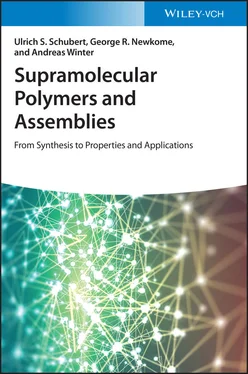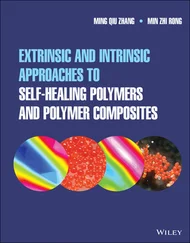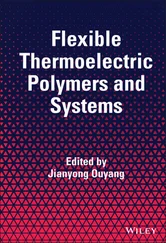Andreas Winter - Supramolecular Polymers and Assemblies
Здесь есть возможность читать онлайн «Andreas Winter - Supramolecular Polymers and Assemblies» — ознакомительный отрывок электронной книги совершенно бесплатно, а после прочтения отрывка купить полную версию. В некоторых случаях можно слушать аудио, скачать через торрент в формате fb2 и присутствует краткое содержание. Жанр: unrecognised, на английском языке. Описание произведения, (предисловие) а так же отзывы посетителей доступны на портале библиотеки ЛибКат.
- Название:Supramolecular Polymers and Assemblies
- Автор:
- Жанр:
- Год:неизвестен
- ISBN:нет данных
- Рейтинг книги:3 / 5. Голосов: 1
-
Избранное:Добавить в избранное
- Отзывы:
-
Ваша оценка:
- 60
- 1
- 2
- 3
- 4
- 5
Supramolecular Polymers and Assemblies: краткое содержание, описание и аннотация
Предлагаем к чтению аннотацию, описание, краткое содержание или предисловие (зависит от того, что написал сам автор книги «Supramolecular Polymers and Assemblies»). Если вы не нашли необходимую информацию о книге — напишите в комментариях, мы постараемся отыскать её.
The book details many of the exciting developments in the field of supramolecular chemistry that have occurred since the 1987 Nobel Prize was awarded to pioneers in this rapidly developing field. Readers will also benefit from the inclusion of:
A thorough introduction to supramolecular assemblies based on ionic interactions Explorations of supramolecular polymers based on hydrogen-bonding interactions, metal-to-ligand interactions, p-Electronic interactions, crown-ether recognition, cucurbiturils, and host-guest chemistry of calixarenes A discussion of cyclodextrins in the field of supramolecular polymers Examinations of supramolecular polymers based on the host-guest chemistry of pillarenes, and those formed by orthogonal non-covalent interactions A treatment of the characterization of supramolecular polymers
will earn a place in the libraries of researchers and practitioners of the material science, as well as polymer chemists seeding a one-stop reference for supramolecular polymers.
Supramolecular Polymers and Assemblies — читать онлайн ознакомительный отрывок
Ниже представлен текст книги, разбитый по страницам. Система сохранения места последней прочитанной страницы, позволяет с удобством читать онлайн бесплатно книгу «Supramolecular Polymers and Assemblies», без необходимости каждый раз заново искать на чём Вы остановились. Поставьте закладку, и сможете в любой момент перейти на страницу, на которой закончили чтение.
Интервал:
Закладка:
10 Chapter 10Figure 10.1 Schematic representation of pillar[5]arene ( 1) and two cationic guests ( 2and 3) that formed host–guest complexes of 1 : 1 stoichiometry with 1. Source: Ogoshi et al. [1]. © 2008 American Chemical Society.Figure 10.2 Schematic representation of the viologen oligomers 4used as macromolecular guests.Figure 10.3 Schematic representation of the pillar[5]arene‐based pseudorotaxane of PANI's emeraldine base and its reduction to the leucoemeraldine species.Figure 10.4 Schematic representation of the chain extension of polyethylene induced by the threading of 1onto the chains. Source: Ogoshi et al. [29]. © 2013 Springer Nature.Figure 10.5 (a) Schematic representation of the pillar[5]arene‐based polymer‐containing rotaxanes 5. (b) Representation of the Ru‐catalyzed cross‐linking of 5binto a topological polymer gel. Source: Ogoshi et al. [31]. © 2014 The Royal Chemical Society.Figure 10.6 Schematic representation of the host–guest conjugate 6and its reversible formation of a self‐inclusion complex. Source: Guan et al. [33]. © 2011 The Royal Chemical Society.Figure 10.7 Schematic representation of the monofunctional pillar[5]arenes 7that assembled into supramolecular dimers ( 7aand 7b) or a supramolecular polymer ( 7c). (a) Ball‐and‐stick model of such a supramolecular dimer. (b) Representative SEM image of a gold‐coated fiber of ( 7c) n. Source: Liu et al. [35]. © 2012 American Chemical Society.Figure 10.8 Schematic representation of the host–guest conjugate 8. (a) Image of the supramolecular gel ( 8) n; (b) optical microscopy image (500×) of aggregates of ( 8) n; (c) SEM image of the gel in CH 2Cl 2. Source: Strutt et al. [38]. © 2012 The Royal Chemical Society.Figure 10.9 Schematic representation of the photo‐switchable host–guest conjugate 9and its self‐assembly into supramolecular architectures. Source: Wang et al. [45]. © 2014 The Royal Chemical Society.Figure 10.10 Schematic representation of the host–guest conjugate 10that assembled into a linear supramolecular polymer and, subsequently into aggregates via π–π stacking interactions. Source: Fathalla et al. [46]. © 2015 The Royal Chemical Society.Figure 10.11 Schematic representation of the BODIPY‐containing host ( 11) and guest molecules ( 12and 13). For the supramolecular polymer ( 11 … 12) n, FRET from the donor dye to the acceptor one was observed. Source: Meng et al. [49]. Figure reproduced with kind permission; © 2015 The Royal Chemical Society.Figure 10.12 Schematic representation of the two‐step self‐assembly of the pillarene‐based building blocks 14and 15into a supramolecular polymer. Source: Wang et al. [51]. © 2013 The Royal Chemical Society.Figure 10.13 Schematic representation of the fluorescent host 16and guests 17which were employed, as monomers, to assemble linear supramolecular polymers. The device configuration, containing these materials, as emissive layer (EML), as well as the obtained electroluminescence spectra are also depicted. Source: Yang et al. [52]. © 2017 American Chemical Society.Figure 10.14 Schematic representation of the formation of a dynamic polyrotaxane via a two‐step self‐assembly process. A TEM microscopy image of the supramolecular polymer obtained from 1,4‐diaminobutane ( n = 4) is also shown. Source: Hu et al. [54]. Figure reproduced with kind permission; © 2012 American Chemical Society.Figure 10.15 Schematic representation of the two‐step self‐assembly of a polypseudorotaxane containing X‐bonding and host–guest interactions within the main and the side chains, respectively. The solid‐state structure of the assembly, as determined by XRD analysis is depicted. A comparison of the diffusion coefficients ( D ), as determined by DOSY measurements as well as a SEM image of the materials are also shown. Source: Liu et al. [55]. Figure reproduced with kind permission; © 2018 Wiley‐VCH.Figure 10.16 Schematic representation of the formation of a double‐dynamic polymer, based on supramolecular host–guest interactions and dynamic covalent chemistry. Source: Xu et al. [56]. © 2013 American Chemical Society.Figure 10.17 Schematic representation of a supramolecular polymer, based on an exo‐wall and endo‐cavity complexation. Source: Wang et al. [59]. © 2015 The Royal Chemical Society.Figure 10.18 Schematic representation of the synthesis of columnar oligo‐pillarenes according to Stoddard et al. ( n = 0–9). Source: Strutt et al. [60]. © 2014 John Wiley and Sons.Figure 10.19 Schematic representation of the self‐assembly of 22into a hyperbranched supramolecular polymer. The distribution of the hydrodynamic diameter ( R h) according to DLS as well as a representative TEM image of the obtained nanoparticles are also shown. Source: Xiaoyang et al. [61]. Figure reproduced with kind permission; © 2013 John Wiley and Sons.Figure 10.20 (A) Schematic representation of the formation of a dynamic supramolecular polymer network. (B) The TEM images of the polymer at certain concentrations are also shown [(a–c) 1, 2, and 5 mM]. Source: Zhang et al. [62]. Figure reproduced with kind permission; © 2013 The Royal Chemical Society.Figure 10.21 Schematic representation of the two‐step self‐assembly of a cross‐linked supramolecular polymer. Source: Hu et al. [69]. © 2013 The Royal Chemical Society.Figure 10.22 Schematic representation of the PPE‐type polymer 25and an anion‐responsive polypseudorotaxane prepared thereof. Source: Sun et al. [71]. Figure reproduced with kind permission; © 2013 The Royal Chemical Society.Figure 10.23 Schematic representation of the amphiphilic pillar[5]arene 26and the nanostructures assembled thereof. Source: Yao et al. [73]. © 2012 American Chemical Society.Figure 10.24 Schematic representation of the amphiphilic pillar[5]arene 27and its reversible self‐assembly into a gel‐like material or reverse giant vesicles. Source: Gao et al. [78]. Figure reproduced with kind permission; © 2013 The Royal Chemical Society.Figure 10.25 Schematic representation of the reversible vesicle formation via supramolecular interactions between pillar[6]arene 29and the photo‐switchable guest 28. Source: Yu et al. [81]. Figure reproduced with kind permission; © 2012 American Chemical Society.Figure 10.26 Schematic representation of drug‐loaded vesicles exhibiting a light‐induced release. Source: Hu et al. [82]. © 2015 John Wiley and Sons.Figure 10.27 Schematic representation of the self‐assembly of 30and 31into vesicular nanoparticles; the TEM images show representative nanoparticles observed in both cases (scale bar: 200 nm). Source: Cao et al. [86]. Figure reproduced with kind permission; © 2015 American Chemical Society.
11 Chapter 11Figure 11.1 The important combinations of orthogonal supramolecular interactions. Source: Li et al. [17]. © 2012 The Royal Chemical Society.Figure 11.2 (a) Schematic representation of the metallo‐supramolecular polymer 1; (b) performance of 1in an asymmetric hydrogenation reaction compared with Rh(I)‐MonoPhos, as the benchmark. Source: Yu et al. [9]. © 2010 John Wiley and Sons.Figure 11.3 Schematic representation of the bis‐terpyridine ligand 2that was used for the formation of the homometallic and heterobimetallic metallopolymers comprising Fe(II) and/or Ru(II) ions. The polymers exhibited pronounced characteristics in their photophysical properties as revealed by their coloration that could be switched electrochemically by applying an external voltage. Source: Hu et al. [37]. Figure reproduced with kind permission; © 2013 The Royal Chemical Society.Figure 11.4 Schematic representation of the heteroditopic macroligands 3and 4, as monomers for the preparation of multi‐stimuli‐responsive supramolecular polymers of high molar mass. Source: Hofmeier et al. [39]. © 2005 American Chemical Society.Figure 11.5 Schematic representation of the self‐assembly of 5and 6in presence of Fe(II) ions. Source: Grimm et al. [45]. © 2011 John Wiley and Sons.Figure 11.6 Schematic representation of supramolecular block copolymers 7–9, based on metal‐to‐ligand coordination and H‐bonding interactions. Source: Mansfeld et al. [48]. © 2013 The Royal Chemical Society.Figure 11.7 Schematic representation of the self‐assembly of 10and Pd(II) ions into a double‐cross‐linked polymer. Source: Chen et al. [50]. © 2019 The Royal Chemical Society.Figure 11.8 (a) Schematic representation of the formation of a double‐stranded helical supramolecular polymer via metal‐to‐ligand coordination and ionic interactions. (b) Representation of the size distribution of the polymer (data derived from DLS measurements). Source: Ikeda et al. [51]. © 2006 American Chemical Society.Figure 11.9 Schematic representation of the heteroditopic building block 12and its use in the formation of a multi‐stimuli‐responsive supramolecular polymer. Source: Gröger et al. [52]. © 2011 American Chemical Society.Figure 11.10 Schematic representation of a supramolecular pseudorotaxane with Pd(II) complexes in the main chain. Source: Zhu et al. [54]. © 2011 American Chemical Society.Figure 11.11 (a) Schematic representation of the two‐step, self‐assembly of 15into a cross‐linked supramolecular polymer; (b) representative SEM images of ( 15) nwith increasing amount of Pd(II) ions (top to bottom: 0%, 20%, 60%, and 100%, respectively). Source: (a) Yan et al. [59]. © 2011 John Wiley and Sons, (b) Yan et al. [59]. Figure reproduced with kind permission; © 2012 Wiley‐VCH.Figure 11.12 Schematic representation of the supramolecular gel formed by the cross‐linking of metallocages via crown ether recognition. The material exhibited a multi‐stimuli‐responsive behavior (e.g. switchability between a gel‐like and liquid state). Source: Lu et al. [60]. Figure reproduced with kind permission; © 2018 American Chemical Society.Figure 11.13 Schematic representation of the formation of the 1 : 1 complex 16@CB[6] and its metallo‐supramolecular polymerization into linear chains or a 2D polymer networks when Cu(II) or Ag(I) ions, respectively, are added. Source: Whang et al. [62]. © 1996 American Chemical Society.Figure 11.14 Schematic representation of the two‐step assembly of 16– 17with CB[6] and Cd(II) ions into a double‐chained supramolecular 1D polymer. Source: Redrawn from Park et al. [63].Figure 11.15 Schematic representation of the typ ligands 18–20, as monomers, for the two‐step supramolecular polymerization: (a) homometallic polymer, based on homotrimeric host–guest complexes, and (b) heterobimetallic polymer, based on heterotrimeric host–guest complexes. Source: (a) Liu et al. [70]. © 2013 The Royal Chemical Society, (b) Joseph et al. [71]. © 2014 American Chemical Society.Figure 11.16 Schematic representation of supramolecular triblock copolymer 21.Source: Yang et al. [73]. © 2010 American Chemical Society.Figure 11.17 Schematic representation of the formation of 1D‐stacks from 22by synergistical H‐bonding interactions. Source: Nieuwenhuizen et al. [75]. © 2010 John Wiley and Sons.Figure 11.18 Schematic representation of homoditopic polymer 23. The AFM imaging revealed fiber formation as a result from substituents in 6‐position (scale bar: 100 nm). Source: Appel et al. [76]. Figure reproduced with kind permission; © 2011 American Chemical Society.Figure 11.19 Schematic representation of polymers 24–26and their self‐assembly behavior. Source: Mes et al. [79]. © 2011 American Chemical Society.Figure 11.20 Schematic representation of the supramolecular architecture 27. Source: Shao et al. [81]. © 2004 American Chemical Society.Figure 11.21 Schematic representation of monomers 28and 29as well as their self‐assembly into a linear supramolecular polymer; the SEM image of a fiber grown from ( 28⋅⋅⋅ 29) nis also shown. Source: Li et al. [85]. Figure reproduced with kind permission; © 2011 The Royal Chemical Society.Figure 11.22 Schematic representation of the self‐assembly of 30and 31into a pseudorotaxane network. Source: Li et al. [87]. © 2011 The Royal Chemical Society.Figure 11.23 (a) Schematic representation of the self‐assembly of a star‐shaped molecule 32into a helical columnar triplex; (b) schematic representation of the fabrication of an ordered array of columnar lines on a mica substrate. Source: van Hameren et al. [88]. © 2008 American Chemical Society.Figure 11.24 (a) Schematic representation of OPE 33and (b) its concentration‐dependent self‐assembly into nanoparticles, microspheres or giant fibrillar structures. Source: Ajayaghosh et al. [90]. © 2006 John Wiley and Sons.Figure 11.25 Schematic representation of the two‐step, self‐assembly of 34and 35into a supramolecular superlattice; the polarizing optical microscope (POM) image is also shown ( 34‐to‐ 35ratio of 8 : 1, 100 °C). Source: Fitié et al. [92]. © 2008 American Chemical Society.Figure 11.26 Schematic representation of the self‐assembly of 36into supramolecular polymers and grafted polymers (in the absence and presence of 37, respectively). Representative TEM images of the spherical micelles and 1D fibers, obtained from the coassembly of 36with 37aand 37b, respectively, are also shown. Source: Jamadar and Das [94]. © 2020 The Royal Chemical Society.Figure 11.27 Schematic representation of the hierarchical self‐assembly of the sulfonamide‐functionalized oligopeptide 38. Source: Teng et al. [96]. © 2019 John Wiley and Sons.Figure 11.28 Schematic representation of the supramolecular polymerization of 39and 40due to orthogonal host–guest complexation. Source: Wang et al. [98]. © 2008 American Chemical Society.Figure 11.29 Schematic representation of the polypseudorotaxane formation via an orthogonal three‐component self‐assembly process. Source: Wang et al. [103]. © 2009 The Royal Chemical Society.Figure 11.30 Schematic representation of the self‐assembly of a polycationic dendron with naphthalene dicarboxylic acids into cylindrical and spherical aggregates. Source: Redrawn from Gröhn et al. [104]. © 2019 John Wiley and Sons.Figure 11.31 Schematic representation of the pair of oppositely charged porphyrins ( 41 2−and 42 4+/5+); a representative TEM image of the resultant nanotubes is also shown (inset: a tube trapped in a vertical orientation by a thick mat of tubes). Source: Wang et al. [109]. Figure reproduced with kind permission; © 2004 American Chemical Society.Figure 11.32 Schematic representation of the oppositely charged PBI ( 43) and phthalocyanine dyes ( 44), which gave a supramolecular helically stacked superstructure. Source: Guan et al. [110]. © 2005 John Wiley and Sons.Figure 11.33 Schematic representation of the proposed model of the two‐step, self‐assembly of the carboxy‐functionalized NBI 45and the tetra‐cationic guanidiniocarbonyl pyrrole 46. Source: Samanta et al. [113]. © 2005 John Wiley and Sons.Figure 11.34 Schematic representation of the functionalized monomers 47and 48. (a) Schematic representation of the supramolecular polymer formed by 47, CB[8], and 48in a directional two‐step assembly approach. (b) The AF4 elution curve of the supramolecular polymer (water, as eluent, UV detector). Source: Song et al. [114]. © 2014 The Royal Chemical Society.Figure 11.35 Schematic representation of the heteroditopic monomers 49–51used for the sequence‐controlled supramolecular copolymerization. Source: Hirao et al. [117]. © 2017 Springer Nature.Figure 11.36 Schematic representation of the formation of a supramolecular polymer due to CT interactions and pillar[5]arene‐based host–guest complexation. Source: Chen et al. [118]. © 2016 The Royal Chemical Society.Figure 11.37 (a) Schematic representation of the self‐assembly of the a myoglobin‐dimer and streptavidin with heme‐bis(biotin) conjugate 52; (b) AFM height image of the supramolecular polymer on a modified mica substrate (100 mM K 3PO 4buffer, pH value of 7); (c) SEC traces (UV/vis absorption detector) of the supramolecular polymer (solid line) and the fragment obtained after cleavage of the disulfide bridges (dashed line). Source: Oohara et al. [24]. Figure reproduced with kind permission; © 2012 Wiley‐VCH.Figure 11.38 (a) Schematic representation of the formation of the supramolecular polymers ( 53) n, based on protein recognition. (b) SEC analysis of ( 53) nusing reference proteins, as standards. Source: Kitagishi et al. [123]. © 2007 American Chemical Society.Figure 11.39 Schematic representation of the reversible switching between a thermodynamically and a kinetically stable architecture (linear polymer chain vs. spherical micelle). Source: Oohora et al. [124]. © 2017 The Royal Chemical Society.
Читать дальшеИнтервал:
Закладка:
Похожие книги на «Supramolecular Polymers and Assemblies»
Представляем Вашему вниманию похожие книги на «Supramolecular Polymers and Assemblies» списком для выбора. Мы отобрали схожую по названию и смыслу литературу в надежде предоставить читателям больше вариантов отыскать новые, интересные, ещё непрочитанные произведения.
Обсуждение, отзывы о книге «Supramolecular Polymers and Assemblies» и просто собственные мнения читателей. Оставьте ваши комментарии, напишите, что Вы думаете о произведении, его смысле или главных героях. Укажите что конкретно понравилось, а что нет, и почему Вы так считаете.












